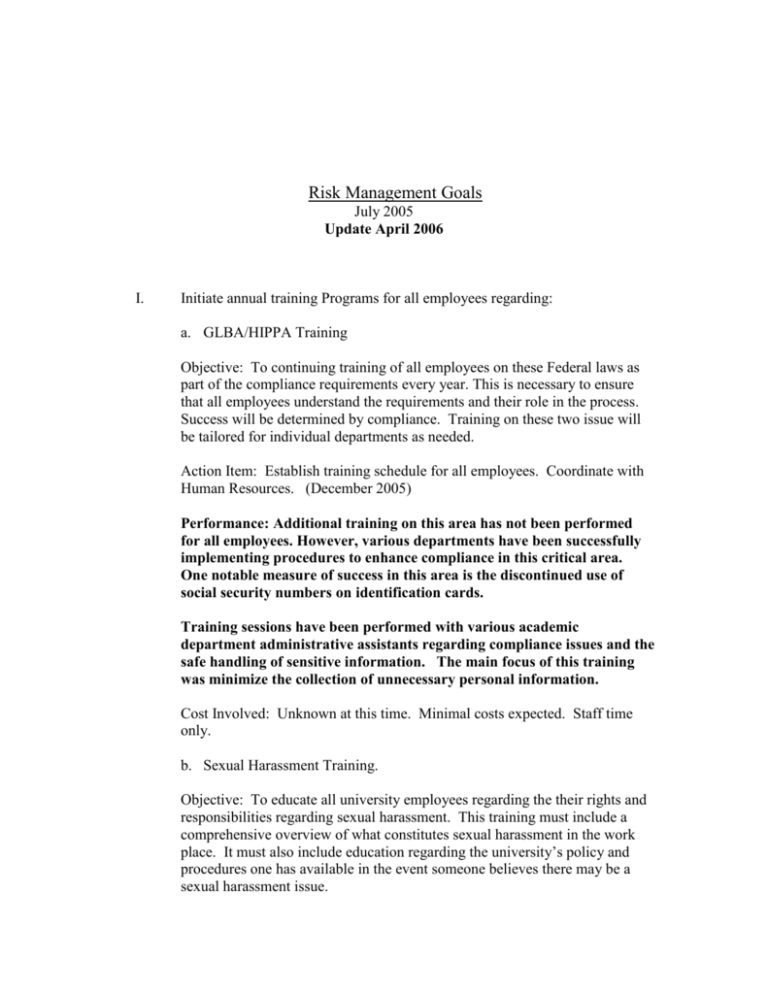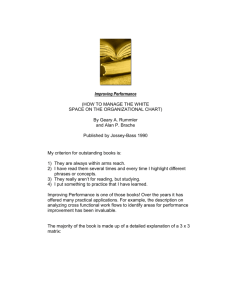
Risk Management Goals
July 2005
Update April 2006
I.
Initiate annual training Programs for all employees regarding:
a. GLBA/HIPPA Training
Objective: To continuing training of all employees on these Federal laws as
part of the compliance requirements every year. This is necessary to ensure
that all employees understand the requirements and their role in the process.
Success will be determined by compliance. Training on these two issue will
be tailored for individual departments as needed.
Action Item: Establish training schedule for all employees. Coordinate with
Human Resources. (December 2005)
Performance: Additional training on this area has not been performed
for all employees. However, various departments have been successfully
implementing procedures to enhance compliance in this critical area.
One notable measure of success in this area is the discontinued use of
social security numbers on identification cards.
Training sessions have been performed with various academic
department administrative assistants regarding compliance issues and the
safe handling of sensitive information. The main focus of this training
was minimize the collection of unnecessary personal information.
Cost Involved: Unknown at this time. Minimal costs expected. Staff time
only.
b. Sexual Harassment Training.
Objective: To educate all university employees regarding the their rights and
responsibilities regarding sexual harassment. This training must include a
comprehensive overview of what constitutes sexual harassment in the work
place. It must also include education regarding the university’s policy and
procedures one has available in the event someone believes there may be a
sexual harassment issue.
Action Item: To be completed by December of 2005 for all college
employees.
Performance: Not accomplished at this time.
II
Safety Training Updates for Targeted Employees Whose Job Functions Require
Specialized Training:
a. Safety Training for Physical Plant Employees regarding safe work
practices:
b. Confined space training for all employees who may possibly engage is
such activities.
c. Create a safety manual for the physical plant employees. The manual
should include general policies and procedures specifically tailored the for
university functions.
Objective: Minimize the number of injuries and workers’ compensation
claims. Prevent any injuries or situations that may arise from this type of
activity.
Action Item: Coordinate with Physical Plant and Environmental Safety
Officer.
Performance: The college as part of its MHEC membership has access to
engineering services and safety prevention specialists. The university has
utilized these services three times in the last year. Specific areas
addressed by these services relating to this goal include hot work permit
procedures and electrical safety measures. A new hot work permit
procedure has been implemented.
Additional training has been performed on the bio-hazard clean-up
procedures. This training has been targeted towards the custodial staff
and the public safety department: the two departments most likely to
come into contact with such issues. Bio-hazard clean-up kits have been
made and put together and placed in various locations around campus.
Please note that these items and procedures were vitally important in the
unfortunate incident in the resident hall this spring.
The number of back related injuries to our physical plant employees has
been reduced to the last two years. We attribute this to continued training
on lifting safety.
Costs: Approximately $300
d. Driver’s Training for all employees who operate college vehicles.
Objective: To ensure all drives all college vehicles have been adequately
trained in the safe operation of vehicles.
Action Item: Coordinate with the departments who have employees who use
college vehicles to determine training schedule.
Performance: Most departments within the college have been contacted.
Reviews of the universities rules and procedures have been performed.
Although specific training has not been accomplished in terms of actual
driving, we consider this goal to have been successful for unanticipated
reasons. It became apparent the many departments were improperly
using student labor for university driving purposes. There was a
tremendous amount of misunderstanding of our transportation policies.
We have also continued to train all student workers in the safe operation
of the vehicles they use in the scope of their employment. This includes
the use of golf carts, club cars regular motorized vehicles.
Action Item: Retain qualified trainers with the help of an outside agency such
as the St. Joseph Safety Council. (April 2005)
Cost: Unknown
III
Perform a Risk Assessment Analysis Using the Financial Statement Method
Objective: To identify the various types of potential losses confronting the
college. To measure these potential losses with respect to their likelihood of
occurrence and their probable loss.
Action Item: Analysis of financial statements including the balance sheet,
operating statements and supporting records.
Performance: A review of the university’s financial statements was
performed this year. A comparison of previously reported insurance
values with listed assets for various departments was conducted. This
endeavor uncovered areas of discrepancies in several departments. One
notable example was the music department. Due to this analysis, the
music department was asked to do a complete inventory and reevaluation
of all their assets. Previous estimates turned out to be grossly
understated. Please note that many of the items listed the campus fixes
asset inventory were individually under the limits established for listing,
but when actually added up amounted to large asset base. Using this
method has been very successful determining asset evaluation.
Action Item: Review the previous statements with future forecasts and
budgets to determine future exposures.
Performance: See below.
Costs: None, staff time only.
IV.
Perform a “Net Income” loss exposure analysis.
Objective: Identify the net income loss exposure of a business. One aspect of
a potential loss is the loss of income from a termination of certain operations
due to a loss event. These losses can be directly or indirectly related to the
loss event themselves.
Action Item: Identify revenue sources for the college and determine if what
mechanisms may be available to mitigate such losses and exposures.
Performance: This goal was performed through the use of insurance
business interruption worksheet analysis. Comparisons of last years
actual results and projections for the next fiscal year have been made.
In breaking down to sources of income, various critical areas have been
recognized. This analysis will be done every year at insurance policy
renewal time.
Cost: None, staff time only.







